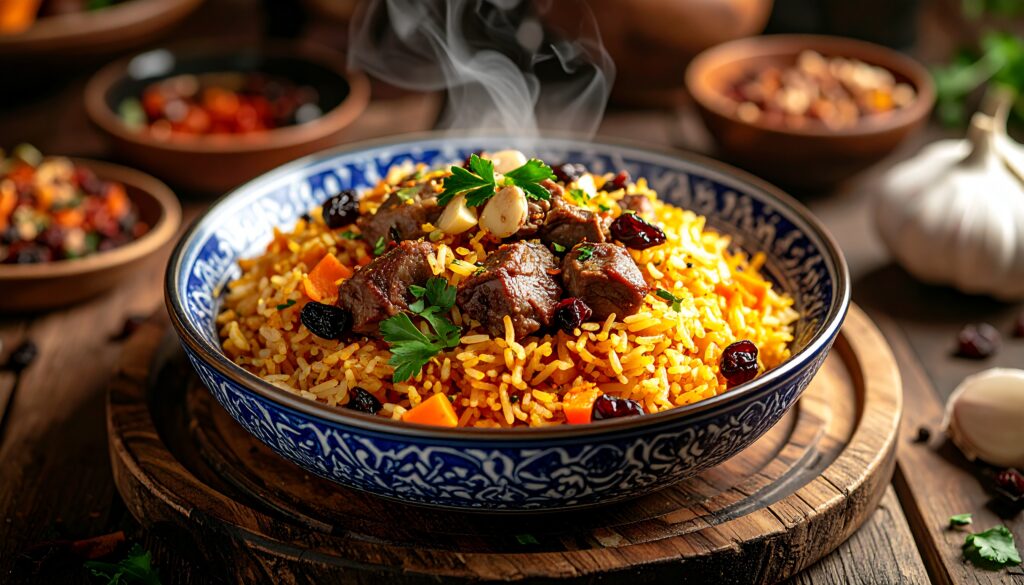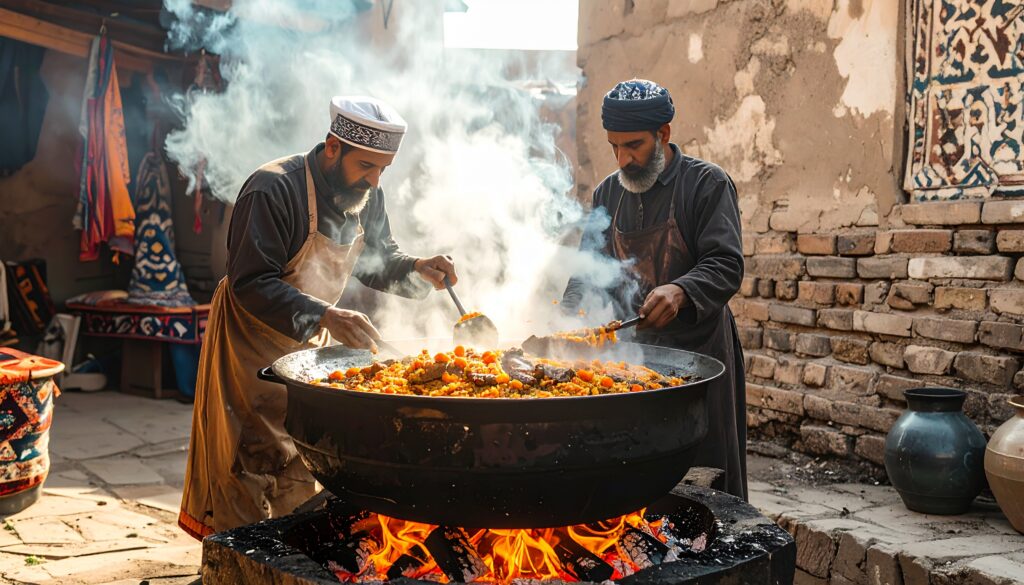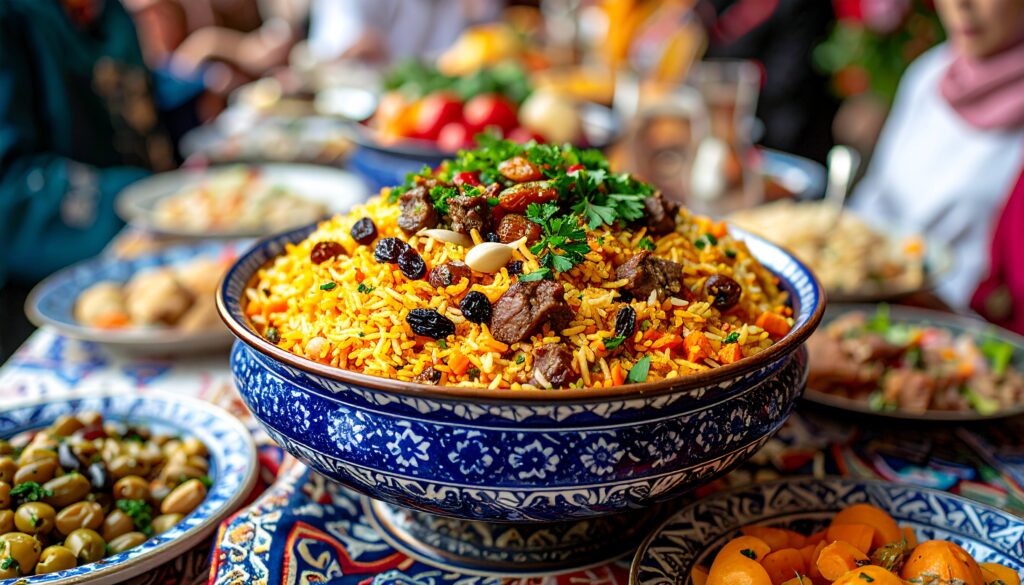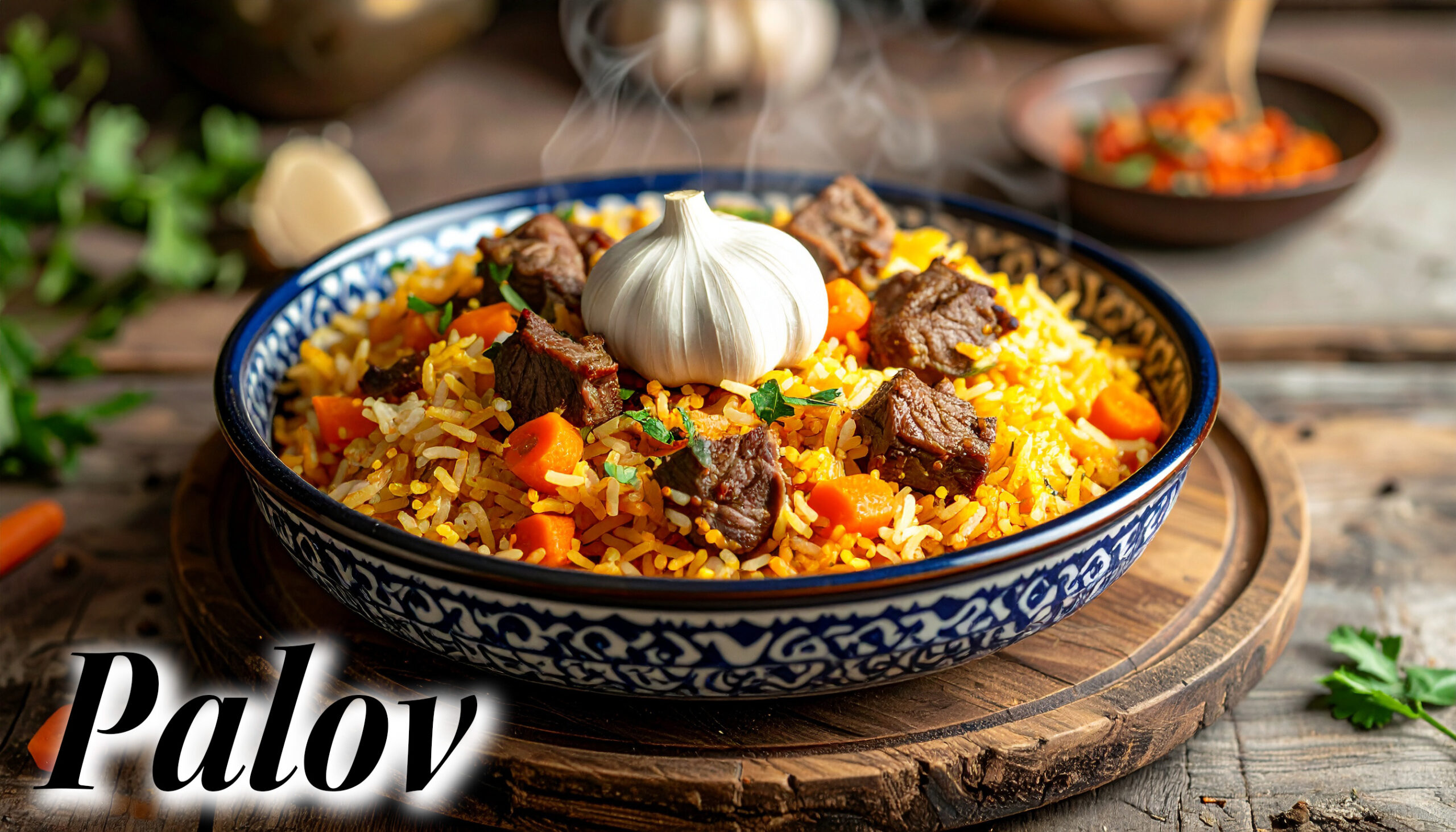Do you know what a palov is?
Palov is a rice dish representative of Central Asia.
The aroma of spices is striking, and the harmony of savory meat and sweet carrots makes this dish truly appealing!
This time, I'll explain everything about palov, including their history and how to create them!
Please enjoy it all the way to the end.
What is a palov?

Plov (Palov / Плов) is a traditional pilaf dish representative of Central Asia.
In Uzbekistan, it is considered a national dish and appears in every situation, from holidays and weddings to funerals and everyday meals.
Each city has its own distinctive features, with styles such as Samarkand-style, Bukhara-style, and Fergana-style.
It is also popular in countries surrounding Uzbekistan, and regional variations exist.
The name's palov is said to come from the Arabic word “Pilaf.”
Therefore, this palov is also considered the prototype for pilafs around the world.
The taste and flavor of palov
Palov is characterized by its rich flavor, where the savory essence of meat blends seamlessly with aromatic vegetables, spices, and oil.
Traditionally, lamb is used for the meat.
Lamb has a distinctive richness and aroma, with a presence that stands up well to the flavors of oil and spices.
Moreover, depending on the grade, it achieves a tender texture that crumbles easily, and the fat permeates the rice, resulting in a rich and savory flavor.
Carrots bring out the sweetness in palov.
Carrots, considered the key to flavor, blend with the saltiness of the meat to achieve a perfect balance.
Unlike Indian-style palov, which uses a lot of spices, the spice in palov is restrained and refined.
The main spices used are cumin (jeera) and black pepper.
Occasionally, barberries (tart red berries) or raisins are added to impart a sweet-and-sour flavor.
And the key ingredient is oil.
Palov is so rich in oil that it's called “oil-based cuisine.”
However, it doesn't create an unpleasant greasiness; instead, it blends with the savory aroma of the meat to create richness and umami.
These elements blend together, giving palov its complex and addictive flavor.
History of palov

The origins of palov are very ancient, and it is believed to share common roots with pilaf.
Additionally, several legends about the origin of palov are passed down.
A notable example is the one said to have been devised by Avicenna, a scholar and physician, to restore the physical strength of a prince who had fallen ill.
Additionally, there is an anecdote that Alexander the Great ate a similar dish during his expedition to Central Asia.
While none of these have been definitively confirmed as historical facts, they suggest that a similar culinary culture existed in this region from ancient times.
Eventually, palov spread throughout Central Asia, primarily in Uzbekistan.
Palov is a dish made by simmering rice, meat, carrots, and oil in a large pot.
Therefore, it perfectly suited the environment where abundant agricultural products and nomadic culture intersected, becoming an indispensable presence at celebratory and ceremonial tables.
Even today, it is prepared as a dish to celebrate life's milestones, such as weddings, births, and funerals.
Fun Facts and Interesting Stories About palov
The legend that Avicenna devised it
In Uzbekistan, the legend that “palov was invented by the physician Avicenna (Ibn Sina)” is well known.
It is said that he had a dish made using rice, meat, carrots, and oil to restore the sick prince's nutrition.
As a result, the prince made a full recovery, and it is said that this dish became widely known.
This anecdote linking medicine and cooking remains popular with people to this day.
Palov is “a dish for men”

In Uzbekistan, palov is traditionally a dish prepared by men.
At celebrations and large gatherings, men set up large iron pots (kazans) outdoors and cook up plentiful portions of palov for dozens, sometimes even hundreds of people.
This act is called “Osh,” and the cooking process carries a ritualistic meaning.
The Secret of the Word “PALOV”
In Uzbekistan, it is said that the Uzbek spelling of palov, “PALOV,” actually stands for the initial letters of its ingredients.
- P is Uzbek for piyoz, meaning onion.
- A is Ayroz in Uzbek, meaning rice.
- L is Lahm in Uzbek, meaning meat.
- O means “oil” in Uzbek.
- V means “salt,” “carrot,” and other items in Uzbek.
In other words, “PALOV” is a word that directly represents the composition of the dish.
While there are various theories, it is a well-known mnemonic device in Uzbek households.
At weddings, “blessing palov” is served.

At Uzbek weddings, the “blessed palov (To‘y osh)” cooked in large pots early in the morning is an essential part of the celebration.
It is traditional for neighbors and relatives to gather, with the groom's family taking the lead in preparing the meal.
By eating this dish served before the ceremony, participants wish the bride and groom happiness.
Always finish your meal with tea.
After eating palov, it's customary to drink strong green tea (or black tea).
This means “to settle your stomach after a greasy meal.”
Therefore, chai (tea) sets are almost always served at palov shops.
How to Make a Palov
Ingredients (Serves 4–5)
- Rice (preferably long-grain or jasmine rice) ... 2 cups (approx. 300g)
- Lamb or beef (cubed)・・・300g
- Onion...1 (thinly sliced)
- Carrots... 2-3 carrots (thick julienne strips)
- Garlic (with skin, whole)・・・1 head
- Salad oil or cottonseed oil... 5 to 6 tablespoons
- Cumin seeds... 1 teaspoon
- Salt... 1 to 1.5 teaspoons (adjust to taste)
- Black pepper... a pinch
- Water・・・Approximately 400ml
(Optional) You may also add raisins, chickpeas, barberries, etc.
Preparation
- Rinse the rice lightly, then soak it in water for about 30 minutes.
- Cut the meat into bite-sized pieces.
- Cut the carrots into thick matchsticks and slice the onion thinly.
How to make them
- Heat the pot and thoroughly warm the oil.
Heat the oil over medium-high heat until it's just about to smoke. - Stir-fry the meat.
Add the meat and stir-fry thoroughly until the surface is nicely browned. This step creates the savory flavor and aromatic richness. - Add the onion.
Once the meat is cooked through, add the onions and sauté until translucent. - Add the carrots.
Add the carrots and stir-fry until they soften and release a sweet aroma. - Add the spices.
Add cumin, salt, and black pepper, then mix everything together. This step determines the layers of flavor. - Add water and simmer gently.
Add enough water to cover the ingredients and simmer for 5 to 10 minutes. The flavors of the meat and vegetables will infuse into the broth. - Place the rice on top.
Drain the soaked rice in a colander, then spread it evenly in a pot.
The key here is not to mix it. - Place the garlic on top.
Lightly press the whole garlic clove into the rice. - Cook over low heat.
Once it comes to a boil, reduce the heat to low, cover, and simmer for 20 to 25 minutes. - Finish by steaming.
Turn off the heat, let it steam for about 10 minutes, then mix everything together roughly.
The garlic is soft, so you can break it up and mix it in when eating.
Finishing Touches & How to Eat
- The Uzbek way is to plate the dish and place the garlic in the center.
- For an authentic local feel, serve with chai (green tea) if desired.
- Serving a small amount of salad or pickles alongside it helps lighten the heaviness of the oil.
Summary
How was it?
This time, we introduced palov, a rice dish from Central Asia!
It looks incredibly greasy, but there's a way to eat it that takes that into account, and the addictive flavor makes my mouth water!
Central Asia tends to have many pilaf-style rice dishes, often involving pilaf.
Now, regarding the stores in Japan that provide this palov.
Uzbek cuisine can be enjoyed at restaurants located in certain cities within Japan, such as Tokyo and Nagoya.
Since palov is cooked in large quantities using a big pot, it seems to pose a bit of a challenge in terms of preparation for places like restaurants.
The recipes introduced this time are designed to serve 4 to 5 people.
If there's no store nearby, please try making it at home using this as a reference!
This dish offers a taste of Central Asian flavors.
You'll definitely get hooked!
Thank you for watching until the end.
Feel free to check out our other articles too!




Comment